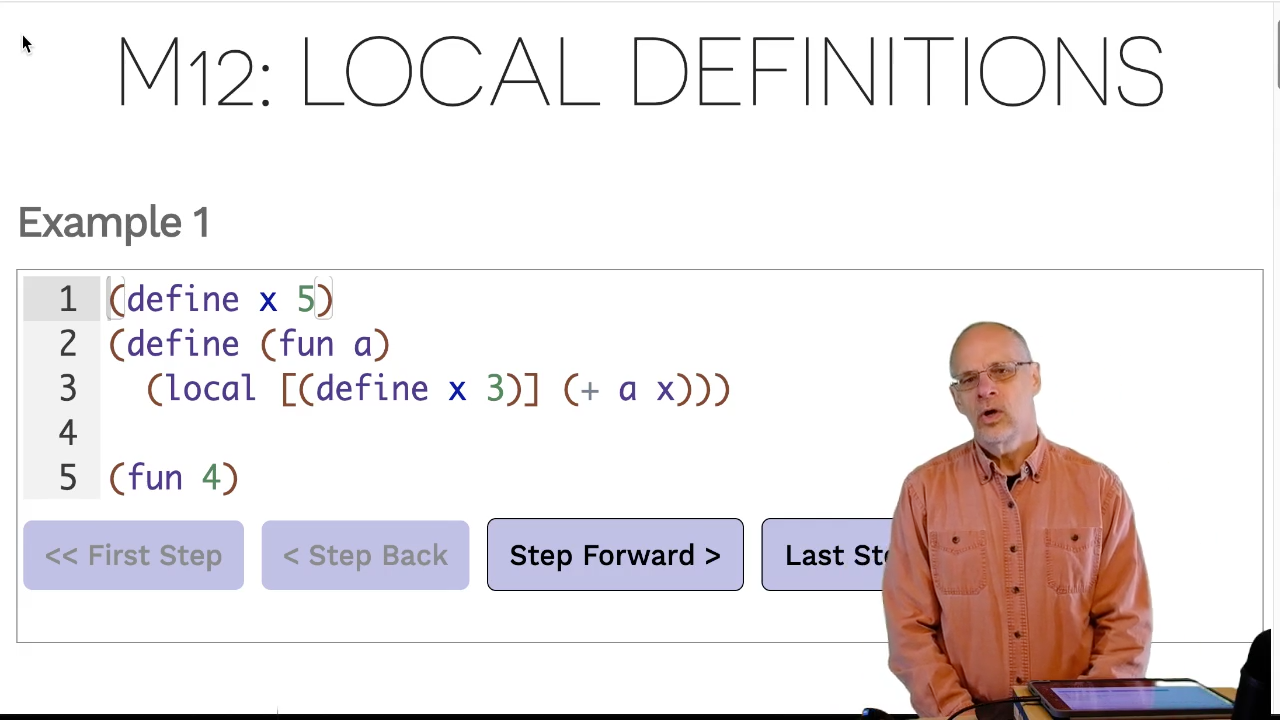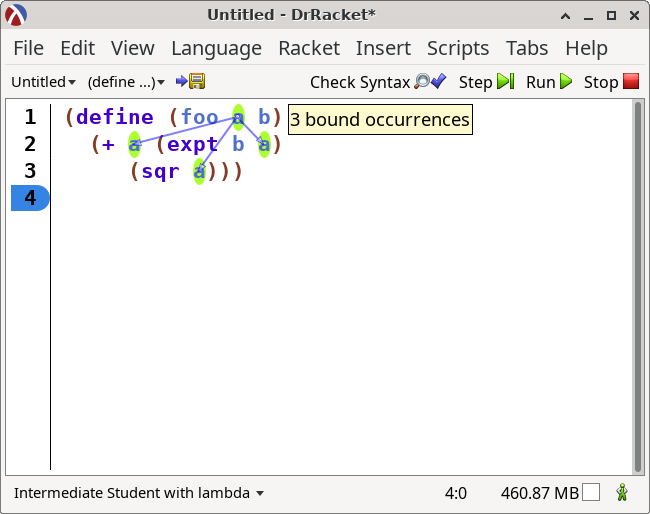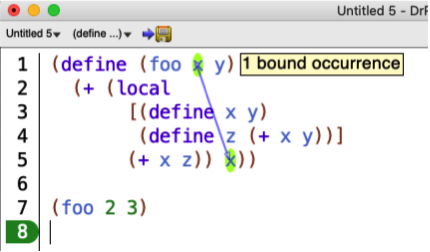M13: Local Definitions
Hint: If possible, make your browser wide enough to place the slides and commentary side-by-side.
The slides on this page are not accessible (for screen readers, etc). The 1up and 3up slides are better.
Module Topics
Change DrRacket’s language level to “Intermediate Student”. Keep the other settings as described in M02-009 .
“Arbitrarily nested” means expressions can have subexpressions, conds inside conds,
lists can be nested within lists, lists can be inside structures (and visa versa), etc.
But that’s not true of define and check-expect.
We’re about to fix that for define. On the other hand, check-expect will always
be required to be at the top level. “At the top level” simply means that it is outside
of everything else; it’s not nested.
This slide and the next several present a computation that seems like it should be easy, but every way we express it has some objection. Those objections are mostly of the form:
- There’s too much repeated code!
- But this doesn’t look like the formula we’re implementing!
- The computations are separated and thus hard to understand!
Professional programmers try to follow the “DRY Principle”. DRY stands for “Don’t Repeat Yourself”.
Repeating yourself:
- Allows bugs to be fixed some places but not others.
- Is often less efficient for the computer.
- Involves more typing for the programmer.
- Means the code must be understood again each time it occurs.
According to Wikipedia , violating the DRY principle results in a WET solution. WET is commonly understood to stand for “Write Every Time”, “Write Everything Twice”, “We Enjoy Typing”, or “Waste Everyone’s Time”.
Here the DRY violation is particularly obvious but not particularly egregious because the code is so simple and concentrated in one place. But it points towards a general problem that needs to be solved.
Obviously, local will be one technique to help “DRY things up”. The other major technique you already
have in your toolbelt: helper functions. In M16, we’ll introduce another technique, higher order
functions.
Here, the helper function calculates the value of s in the original formula.
Note that it’s called four times. This calculation is “cheap” to compute, but many others are not and repeating them four times could have a significant impact on the speed of the program.
The helper function also has a terrible name. But what should you call it? It has no
meaning outside of the calculation of Heron’s formula. So name it calc-s-for-herons-formula?
Yuck!
In addition to being more readable and shorter, this solves the DRY problem.
The code to compute s is not repeated. It doesn’t have to be typed
multiple times and it doesn’t have to be executed multiple times.
But we’d like to keep related code together, if at all possible.
Now, you might be thinking, “t-area-v3 is just a wrapper function; we’ve done that
lots of times and no one has complained.” Uh huh. Now we’re complaining. Because
now we have the means to fix that.
Finally! Advantages of this code:
- It’s DRY. Nothing is repeated.
- Calculations are only performed once.
- It keeps everything related to calculating Heron’s formula together in a single function.
- Because the definition of
sis so contained, we don’t need to give as much thought to naming it.
This code calculates the value of (/ (+ a b c) 2) and binds it to the identifier s. That
value is then used in place of s everywhere in the expression (sqrt (* s (- s a) (- s b) (- s c))).
What do we mean by “permit reuse of names”? In the code on the slide, programmers
have better things to do than worry about whether a parameter name (n) conflicts
with a constant name (also n). So the designers of Racket (and other languages)
defined the rules to make it easy. Names can be reused. In broad strokes, the closest definition
“wins”.
This same principle is extended to local. The following produces (+ 4 3), not
(+ 4 5).
(define x 5)
(define (fun a)
(local [(define x 3)]
(+ a x)))
(fun 4)Our substitution rules will need to handle these kinds of cases.
Example 1
Video: Download m14.10_semantics

- Prepare to apply the user-defined function substitution rule.
- Replace
(fun 4)with the body offunand 4 substituted for the parametera. - Prepare to apply the local substitution rule.
- Apply the local substitution rule. There are several sub-steps that are all done together:
- Come up with a brand new (“fresh”) name for the local definition of
xthat has not been used for anything else in this program. The stepper uses the namex_1. Use that fresh name,x_1, wherever the local definition ofxwas used (e.g. in(+ a x)). - Move the definition of
x(now calledx_1) up to the top level of the program. - Replace what’s left,
(local [] (+ a x_1)), with just the local’s body expression,(+ a x_1).
- Come up with a brand new (“fresh”) name for the local definition of
- Proceed to evaluate the program using the rules we learned before.
It doesn’t matter what the fresh name is, just so long as it hasn’t been used anywhere else
in the program (that is, it really is “fresh”). It could be zorgon_59 or j$%#222. Racket
will choose it and we’ll never know what it chose.
But in our stepping exercises, we’ll simply use the variable name followed by an _1. If we
have a second identifier with the same name, we’ll use _2 and so on. We’ll assume that
our programs won’t have both an x and an x_1, although Racket must handle that case.
Example 2
Video: Download m14.21_semantics

This example introduces a couple of new wrinkles:
- There are multiple parameters to substitute (but that’s not part of the local substitution rule).
- The local definition,
s, is used multiple times. Sos_1will also appear multiple times. - The definition of
sinvolves a computation. It will be performed after the definition is moved to the top level, using the same rules as before.
Example 3
Video: Download m14.30_semantics

A local expression can have multiple definitions. They are all handled together as a
single step.
The formal rule uses a pattern ellipsis (...) and subscripts to indicate an arbitrary number of
local definitions.
Example 4
Video: Download m14.40_semantics

A local definition can be nested in an expression, as seen in this example. It
doesn’t need to be at the top level of the define. Here, it will calculate a
value that is then added to x. In the video we show a similar example where
the local is nested inside the else for a conditional expression.
As you step through the example, pay particular attention to where x, the function
parameter, is substituted and where x, the local definition, is substituted. Within
the local, the (define x y) takes precedence over the parameter. Otherwise,
the parameter is used.
Most programmers prefer to avoid having a local definition that “shadows” a parameter name. Why make things more complicated than they need to be? But it happens and so the rules need to handle it (and you need to know the rules).
Example 5
Video: Download m14.50_semantics

You may be wondering about all the fuss of a new, fresh identifier. The following example shows why it’s needed.
We have two local expressions within foo. Both
define an x and a z that will be lifted out to the top level. If we didn’t have
fresh identifiers for each of them, there would be a conflict.
The first x to be renamed and lifted will be x_1. The second will be x_2.
We’re now going to move more carefully through four reasons to use local. Some of
these recall arguments made during the motivational example at the beginning of the
module; “encapsulation” is new.
This is the second of the four reasons for using local. The four reasons are:
- Clarity: Naming subexpressions
- Efficiency: Avoid recomputation
- Encapsulation: Hiding stuff
- Scope: Reusing parameters
Refer back to Module 09
if you need a refresher on the problems encountered with max-list.
In max-list-v4 we calculate the maximum of the rest of the
list in the recursive case. Once that value has been calculated,
the local allows us to use it multiple times without recalculation.
Recall that it was recalculation that caused the efficiency issues
with max-list-v2.
This is the fourth approach we’ve seen to finding the maximum value in a non-empty list:
max-list-v1used the built-in helper function,max.max-list-v2had two recursive applications that led to significant efficiency issues.max-list-v3solved the problem with an accumulator.max-list-v4solves the problem withlocal.
Of the four, the first one is likely the best approach. Thanks to the built-in helper
function max it’s a simple and direct approach that is also efficient. If max was
not available, then either version 3 or version 4
would likely be considered the best choice.
This version of search-bt-path from Module 11, slide 18
suffers from the same problem as max-list-v2: it
often applies itself twice to the same argument resulting in an explosive growth in
the number of applications as the tree becomes larger.
The left-path is only computed if the outer else clause is reached. The
path is checked and, only if required, is a second local evaluated and the
right-path is computed.
Note that this is not the else (cond pattern from
Module 03, Slide 26
. There is a local in between.
This is the third of the four reasons for using local. The four reasons are:
- Clarity: Naming subexpressions
- Efficiency: Avoid recomputation
- Encapsulation: Hiding stuff
- Scope: Reusing parameters
local also allows functions to be defined. When the local is
evaluated, the function will be renamed with a fresh identifier and
lifted to the top level of the program. For example,
We say the local function is “invisible” because it can’t be used outside of the local. For example, trying to run the following program
(define (gus x)
(local [(define (foo x) (+ x x))]
(* (foo x) (foo (+ x 1)))))
(gus 2)
(foo 2)results in an error: foo: this function is not defined.
That means foo can’t be misused by applying it in an unintended context (outside of gus). It
also means that foo can be removed from the list of functions most programmers need to
worry about (that is, decluttering the top-level namespace).
local is often used with wrapper functions. The wrapped function –
the one that does most of the work –
is defined within the local.
This exercise is a bit more work than most of our exercises. However, once we
introduce higher order functions in M16, this problem can be solved using local
in only four lines of code! Without the techniques of M16 (and using local)
it takes about 9 or 10 lines of code.
Note that insert is only required to have a purpose statement and a contract. Tests are not required (largely because check-expect can’t be nested).
is-even? and is-odd? are each given fresh names and lifted to the program’s top
level. They then act just like any other pair of mutually recursive functions.
This is the last of the four reasons for using local. The four reasons are:
- Clarity: Naming subexpressions
- Efficiency: Avoid recomputation
- Encapsulation: Hiding stuff
- Scope: Reusing parameters
countup-to-v1 is similar to code from M07 where we need a helper function with
two parameters – one for where we are counting from and the other to be our ending point.
But the ending point, to, never changes. We’ve described that as “going along for the ride”.
Note how countup-from has the value of n (3) embedded in it when it
is lifted out to the top level. Handy!
Video: Download m14.70_embedded_values

There’s no need to trace this for more than a couple of steps. Once the function is lifted out, you’ve seen what you need to see.
(countup-to-v2 10) and (countup-to-v2 20) both result in local functions
being lifted to the top level. You may be wondering what happens to
them after they have been evaluated and are no longer needed. There are two parts to the answer.
First, the substitution model is not necessarily the way the computation is actually implemented in DrRacket. It may have a more efficient way to do it.
Second, unneeded resources (including cons cells and lifted functions) are reclaimed in a
process called “garbage collection”.
This is our second implementation of mult-table. The first was
in M08
. The
third (and last!) will come in M16.
There are a lot of values just going along for the ride in this code:
- In
rows-to, bothnrandnc(the number of rows and number of columns) are going for the ride; they never change. - In
cols-to,ncis going along for the ride.
By making rows-to and cols-to local to mult-table, the parameters nr and nc
will be in scope and don’t need to be passed as parameters.
As with countup-to-v2 and its helper method, when the functions rows-to and
cols-to are lifted to the top level they will have the values for nr
and nc “embedded” in the body of the function.
Advantages to this version of mult-table include:
- Making clear that
rows-toandcols-tobelong tomult-tableand are not expected to have other uses. - Not needing to expend effort to determine that
ncandnrreally don’t change as the helper functions execute. - Simplifying the parameters for the helper functions and thus reducing the chances that they are mixed up.
DrRacket can help you with these. If you click “Check Syntax” and then hover your mouse over a binding occurrence, it will draw arrows to the bound occurrences.
Hovering over a bound occurence will draw an arrow from the binding occurrence and highlight the other bound occurences.
For an example of the “holes” mentioned in the definition of “lexical scope”, consider Example 4 from our earlier discussion:
The “holes” are the occurrences of x that are not highlighted due to
(define x y).
When we first discussed the semantics of local we had not yet seen
locally defined functions. This rule takes them into account.
The substitution rule uses indices like _1 to number the definitions in
the local. Indices are used again to for the identifier in each definition
(e.g. x_i). Unfortunately, we’ve ALSO been using indices to indicate the
“fresh” identifiers in our past examples. Here,
the fresh identifier is indicated by tacking on _new. That’s confusing! Sorry,
but we ran out of notational ideas. If you’ve got a better idea of how to
notate this, please let us know!
















































